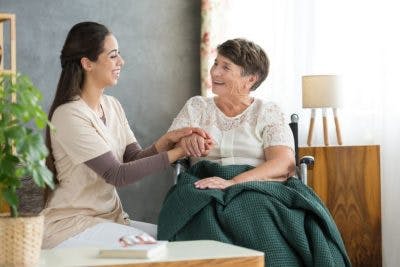Is massage therapy for spinal cord injury recovery effective?
This article will go over the healing effects of massage therapy and how it can help relieve spinal cord injury complications.
Let’s get started!
Benefits of Massage Therapy for Spinal Cord Injury
Massage therapy can help spinal cord injury patients achieve both mental and physical relief.
Massage involves lots of different techniques and varying amounts of pressure. It doesn’t have to be painful to be effective.
It’s essential to communicate with your massage therapist. Let them know where you feel pain, stiffness, or sensitivity for the best therapeutic results.
In the following section, we’ll explain how massage can help alleviate complications of SCI like spasticity, pain, poor sleep quality, and anxiety.
1. Muscle Relaxation
Massage therapy helps stimulate muscles below the site of injury.
Many spinal cord injury patients experience spasticity, which is when the muscles are overactive due to impaired communication between the muscles and the brain, which causes them to involuntarily contract, leading to tightness and muscle shortening.
Massage therapy can help lengthen spastic muscles, which will increase range of motion and reduce stiffness.
2. Improved Circulation
Spinal cord injury patients are more likely to be inactive due to their sensorimotor impairments.
When you don’t move enough, blood starts to pool in your arms and legs, and less of it returns to the heart.
Blood is rich in oxygen and other nutrients that are essential for fueling cellular activity.
Massage therapy helps increase blood flow, which allows all areas of the body to receive a sufficient supply of blood for optimal functioning.
3. Pain Relief

Many spinal cord injury patients experience chronic pain, which can disrupt their quality of sleep, motivation to work on rehabilitation, and ability to perform tasks independently.
Spinal cord injury patients reported massage therapy to be one of the most effective non-pharmacological treatments for their pain.
Massage therapy helps relax muscle tissues, which reduces the occurrence of painful muscle contractions.
4. Minimal Risk
After massage therapy, clients may feel some temporary pain, discomfort, or bruising.
However, the chances of experiencing any severe side effects are very minimal because massage therapy is non-invasive and non-pharmacologic.
5. Improved Mental Health

Adjusting to life after spinal cord injury can be overwhelming and challenging, which is why mental health disorders like depression and anxiety are more common in SCI survivors than the general population.
It’s suggested that massage therapy can decrease stress hormone levels while increasing serotonin levels.
Serotonin plays a significant role in regulating mood, digestion, and quality of sleep.
Does Massage Therapy for Spinal Cord Injury Actually Work?

Is massage therapy for spinal cord injury starting to sound too good to be true?
Well, there are some things to keep in mind.
It’s difficult to measure the effects of massage therapy because you can’t really set up a placebo (you can’t fake a massage).
Therefore, the results are subject to what the patient perceives.
If they believe massage therapy works, they’re probably going to report positive effects. If they’re skeptical, they may not report any difference.
Another downside to massage therapy is that its effects are temporary. You need to continuously go to massage therapy to reap its benefits.
Individually, the sessions may not seem too costly, but when added up, massage therapy sessions may not be the most affordable long-term option.
A Massage Therapist’s Experience
In her 14 years as a massage therapist, Joanie Heart never had a client with spinal cord injury.
When she finally did, she was unsure if she would be able to help him because of the paralysis in his legs.
She remained hopeful and performed the massage. Remarkably, the client reported fewer spasms and reduced pain.
She then began working on many spinal cord injury patients. Every spinal cord injury is different, so she learned to take an individualized approach to each client and their unique condition.
One of her clients first met with her 23 years following his spinal cord injury. Through massage therapy, he was able to increase mobility in his legs and improve his breathing, proving to everyone that it’s never too late for spinal cord injury recovery.
Read more about Joanie Heart’s experience performing massage therapy on SCI patients here.
Understanding Massage Therapy for Spinal Cord Injury

Like most complementary and alternative treatments, high-quality research on the efficacy of massage therapy for spinal cord injury is limited.
However, many spinal cord injury patients are convinced that massage therapy is an effective treatment for SCI-related complications like pain, stress, and muscle tightness.
Because it’s so low-risk, massage therapy may be worth trying before committing to more potentially dangerous alternatives like medication or surgery.











